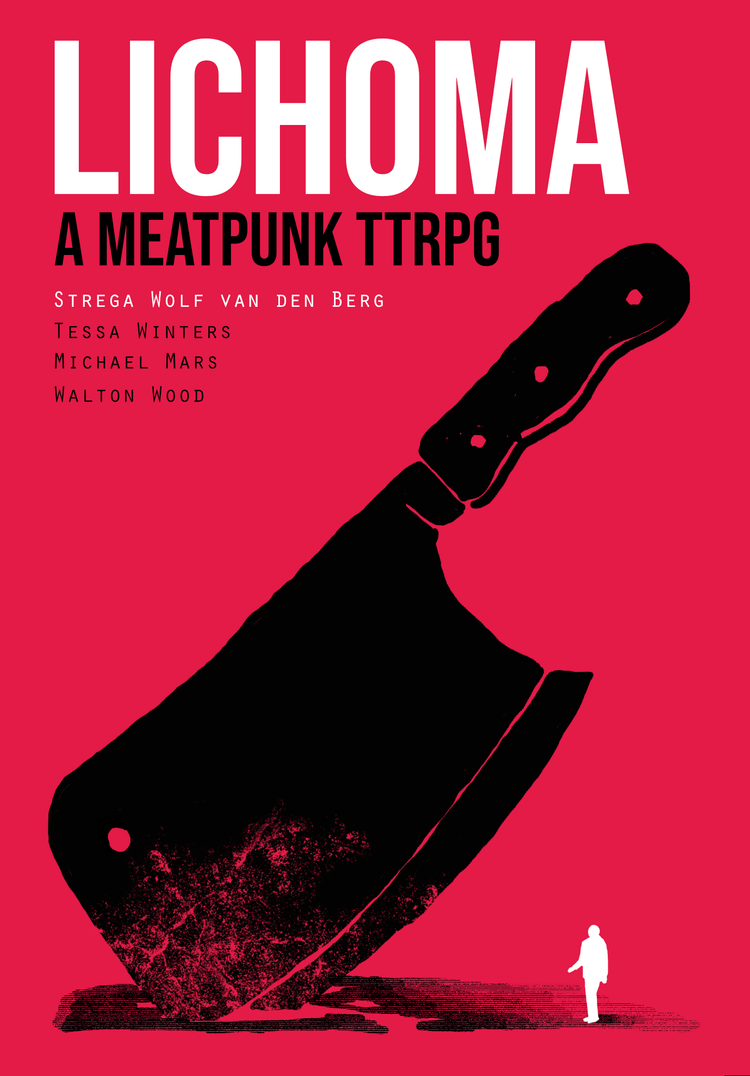
Lichoma picks up where MÖRK BORG left off – at least in its promise of blood splattered adventure in a rotten world. While this game is less oozing apocalypse and more spurting artery, it’s got all of the hallmarks of a beautifully violent offering: hot art, a deadly system and some cannibalism.
Lichoma uses a six-suited deck of cards to represent a few things: the player’s bodies, the factions at play in The Wen and the actions players can take. It all runs off a nifty system where a player creates their character through a drawing of a hand – which can then be used to create a bigger dice pool when the appropriate card makes sense. For example, if you can make the Ally card (with its flavour text, “wolf in sheep’s clothing”) fit the scene for a sneaky attack, the GM will likely allow it.
Which brings us to the callously slaughtered meat of the experience – that of a kind of bartering with the GM. Players suggest how they can enhance their dice pool with their cards and the GM decides if it works. While this should be a natural feeling exchange there does come times when it feels like players are naughty children trying to sneak an extra ice cream. This aspect of the game contains the natural tension of wanting to play out a good story using the elements of the character you’re holding in your hand, and the desire to ‘win’. It’s a tiny and unexpected friction that disappears if everyone relaxes – but it is there.
The cards, and the body parts they represent, are a kind of currency in the game. Once you lose a round with a nasty enemy you’ll have to pick something to lose (or take, usually horrifically described, damage to) – discarding the card to that faction’s remaining deck. Equally, you can ‘salvage’ parts from bodies around you to heal your characters once the current massacre has come to a lull.
There’s something surprisingly simulationist in the way the faction decks rise and fall. Defeat a high value character from that group (in game terms, a Cunt) and you get to take a card from that deck and add it to your faction’s. With this you can track how a faction begins to wither as players whittle away at it. It’s one part of the game that makes its world seem like it’s living and breathing.
Pieces of Eden is the star of the show, illustrating, as any good starter adventure should, what is possible in the system. It’s a grotty search for missing fingers to reattach to what we could call a relic. It’s got a detective story bent to it, if all the characters in Poirot were Leatherface. Players hop between locations and hope to find their way to Elysium, possibly to liberate the only successfully synthetically grown human. As meat is what makes the world of Lichoma go round she’s very much the golden goose. It’s smart, it’s funny, and it’s deftly sketched out in a way that simply demands pace from everyone around the table.
With all this talk of factions and locations you might imagine the world hangs together tightly. Yet, the setting has a very disconnected feel in play. You flash between scenes in a way that’s not exactly cinematic – unless you’re talking Grindhouse. There’s little sense of how the world connects. This is fine as Lichoma isn’t about diving deep into a world but more akin to seeing how far you can skim various body parts from a corpse across a lake of blood. Player’s actions are almost always desperate, and increasingly so are those of the forces they’re up against. There’s a sense that everything is only just held together and it’s exhilarating. Which is to say, when the rhythm of the game hits home, Lichoma is bloody magic.
Editorial note: Walton Wood, a contributor to Wyrd Science, is part of the Bogfolk team behind Lichoma.
Writing: Strega Wolf van den Berg, Michael Mars
Art: Strega Wolf van den Berg
Published by Bogfolk Collective
This feature originally appeared in Wyrd Science Vol.1, Issue 5 (Dec '23)

